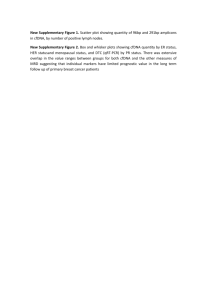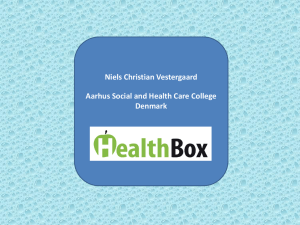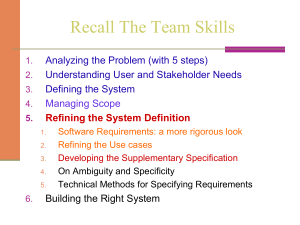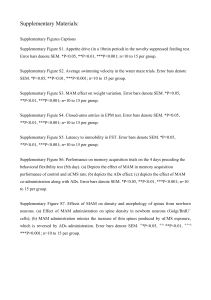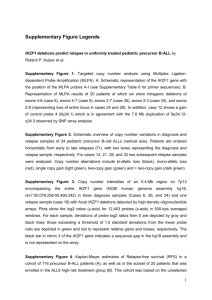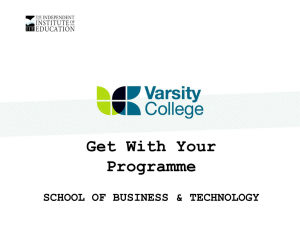a copy of our Word template here
advertisement
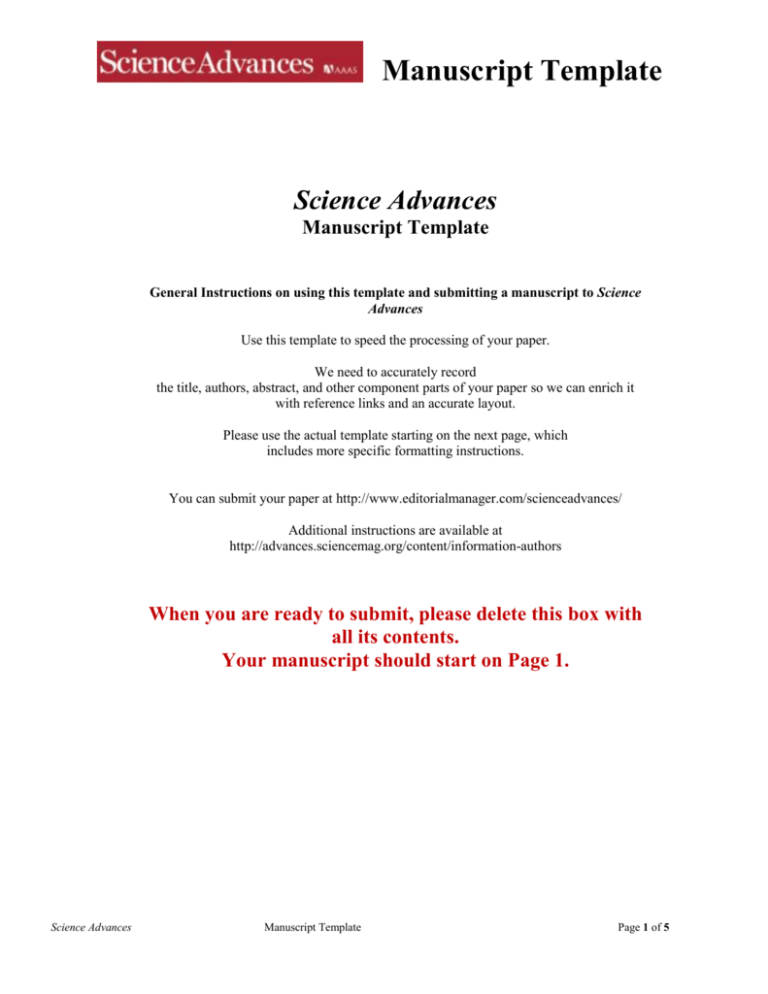
Manuscript Template Science Advances Manuscript Template General Instructions on using this template and submitting a manuscript to Science Advances Use this template to speed the processing of your paper. We need to accurately record the title, authors, abstract, and other component parts of your paper so we can enrich it with reference links and an accurate layout. Please use the actual template starting on the next page, which includes more specific formatting instructions. You can submit your paper at http://www.editorialmanager.com/scienceadvances/ Additional instructions are available at http://advances.sciencemag.org/content/information-authors When you are ready to submit, please delete this box with all its contents. Your manuscript should start on Page 1. Science Advances Manuscript Template Page 1 of 5 H1 FRONT MATTER H2: Title Full titles can be a maximum of 100 characters. Short titles can be a maximum of 40 characters. H2:Authors Example: F. M. Lastname,1* S. I. Lastname,1,2 T. I. Lastname3† Authors should be listed in order of contribution to the paper, by first name, then middle initial (if any), followed by last name and separated by commas. The author list should be one single paragraph with no line breaks. H2:Affiliations Use superscript numbers (1, 2, 3) to designate author affiliations. Each affiliation should be preceded by superscript numbers corresponding to the author list, and each affiliation should end with a period. Each affiliation should be a separate paragraph. You can include group authors, but please include a list of the actual authors (the group members) in the Supplementary Materials. Use an asterisk (*) to identify the corresponding author, and be sure to include that person’s email address. Use symbols (in this order: †, ‡, §, ||, ¶, #, ††, ‡‡, etc.) for author notes such as present addresses, “These authors contributed equally to this work” notations, and similar information. H2:Abstract The abstract should be a single paragraph written in plain language that a general reader can understand. It should include An opening sentence that states the question/problem addressed by the research AND Enough background content to give context to the study AND A brief statement of primary results AND A short concluding sentence. H1 MAIN TEXT H2:Introduction The manuscript should start with a brief introduction that lays out the problem addressed by the research and describes the paper’s importance. The scientific question being investigated should be described in detail. The introduction should provide sufficient background information to make the article understandable to readers in other disciplines, and provide enough context to ensure that the implications of the experimental findings are clear. H2: Results Science Advances Manuscript Template Page 2 of 5 The results should describe the experiments performed and the findings observed. The results section should be divided into subsections to delineate different experimental themes. Subheadings should either be all phrases or all complete sentences. All data must be shown either in the main text or in the Supplementary Materials. All data should be presented in the Results. No data should be presented for the first time in the Discussion. Data (such as from Western blots) should be appropriately quantified. Subheadings must be either all complete sentences or all phrases. They should be brief, ideally less than 10 words. Subheadings should not end in a period. Your paper may have as many subheadings as are necessary. Figures and tables must be called out in numerical order. For example, the first mention of any panel of Fig. 3 cannot precede the first mention of all panels of Fig. 2. The supplementary figures (for example, fig. S1) and tables (table S1) must also be called out in numerical order. Display equations (set on their own line) can be included. Do not use the native Word 2007, 2008, 2010, or 2011 equation editor. This can in produce inaccurate MathML, the online markup language we use, which may result in display errors. Instead, use the legacy equation editor in Word (Insert menu; select insert object; select word equation) or use MathType (recommended). If you enter equations in simple LaTeX, check that they will convert accurately (Word 2007 and higher can convert simple LaTeX equations). Display equations should be numbered at the right—(1), (2), etc. The same guidelines apply to mathematical expressions within a sentence of text; however, MathType (or the equivalent) should be used within text only when the desired result cannot be achieved using ordinary Word characters. Reserve MathType for when its use is unavoidable—for example, characters with overbars or carets, with stacked superscripts and subscripts, or within square root symbols. H2: Discussion Include a Discussion that summarizes (but does not merely repeat) your conclusions and elaborates on their implications. There should be a paragraph outlining the limitations of your results and interpretation, as well as a discussion of the steps that need to be taken for the findings to be applied. Please avoid claims of priority. H2: Materials and Methods The materials and methods section should provide sufficient information to allow replication of the results. Begin with a section titled Experimental Design describing the objectives and design of the study as well as prespecified components. In addition, include a section titled Statistical Analysis at the end that fully describes the statistical methods with enough detail to enable a knowledgeable reader with access to the original data to verify the results. The values for N, P, and the specific statistical test performed for each experiment should be included in the appropriate figure legend or main text. Also see Experimental Design and Statistics Guidelines below for details. Science Advances Manuscript Template Page 3 of 5 All descriptions of materials and methods should be included after the Discussion. This section should be broken up by short subheadings. Under exceptional circumstances, when a particularly lengthy description is required, a portion of the materials and methods can be included in the Supplementary Materials. H2: Supplementary Materials Include supporting text (including supplementary materials and methods, tables, and figures) at the end of the main manuscript file, in a separate section titled Supplementary Materials, if this can be easily done and if the total file size does not exceed 6 MB.Alternatively, Supplementary Materials can be included as a separate file that can be uploaded as the final figure file within the 6 MB upload limit. In that case, use one of the file types specified above (.doc or .docx preferred). If you have any Supplemental Materials please list them by sections in the following order: supplementary materials and methods (if any), supplementary figures, supplementary tables, and other supplementary files (such as movies, data, interactive images, or database files). Be sure to submit all Supplementary Materials with the manuscript. Example: Materials and Methods Fig. S1. Title of the first supplementary figure. Fig. S2. Title of the second supplementary figure. Table S1. Title of the first supplementary table. Data file S1. Title of the first supplementary data file. Movie S1. Title of the first supplementary movie. H2: References and Notes There is only one reference list for all sources cited in the main text, figure and table legends, and Supplementary Materials. Do not include a second reference list in the Supplementary Materials section. References cited only in the Supplementary Materials section are not counted toward length guidelines. Each reference should have a separate number and should be on a separate line ending in a period. See the Author Instructions for details of correct reference style, with examples. You can use a numbered list in MS Word. Please do not include any extraneous language such as explanatory notes as part of a reference to a given source. Science Advances prefers that manuscripts do not include end notes; if information is important enough to include, please put into main text. If you need to include notes, please explain why they are needed in your cover letter to the editor H2:Acknowledgments Acknowledgments, when needed, should include the following information in the order listed below, a single paragraph, starting with the word “Acknowledgments:” in bold. Please use the subhead and boldface layout as shown below.). H3: General: Thank others for any contributions. Science Advances Manuscript Template Page 4 of 5 H3: Funding: Include all funding sources, including grant numbers and funding agencies. H3: Author contributions: Describe the contributions of each author (use initials) to the paper. H3: Competing interests: Include any financial interests of the authors that could be perceived as being a conflict of interest. Also include any awarded or filed patents pertaining to the results presented in the paper. If there are no competing interests, please state so. H3: Data and materials availability: If data are in an archive, include the accession number or a placeholder for it. Also include any materials that must be obtained through an MTA. Acknowledgments follow the references but are not numbered. H2: Figures and Tables You should embed your figures within the Word file, after the acknowledgments. This will facilitate evaluation of the paper. Fig. 1. Short title of the first figure. The figure legend should begin with a title (an overall description of the figure, in boldface) followed by additional text. Each legend should be placed immediately after its corresponding figure. Fig. 2. Short title of the second figure. Indicate figure parts with bold capital letters: (A), (B), etc. Table 1. Short title of the first table. Start table legends with a title (short description of the table). Format tables using the Word Table commands and structures. Do not use spaces or tabs to create tables. H2: Supplementary Materials Include the text, figures, and tables of the Supplementary Materials at the end of your Word manuscript if possible. Include captions for other file types (see below). Supplementary figures should be embedded in the Word file in order, with the legends directly below the figure. Any references cited in the Supplementary Materials must already appear in the reference list; no separate supplementary reference list should be created. Supplementary Materials may include additional author notes—for example, a list of group authors. Add captions for additional file types that cannot be embedded into the Word file. These may include: Movies S1 to S# Audio files S1 to S# Data files S1 to S# Science Advances Manuscript Template Page 5 of 5



